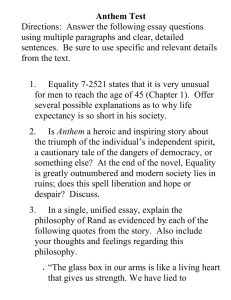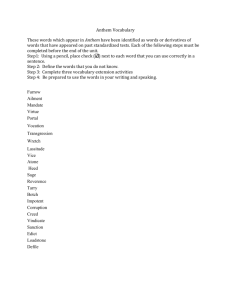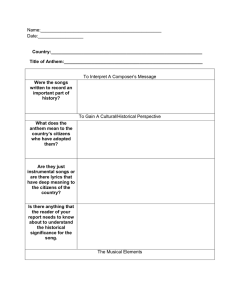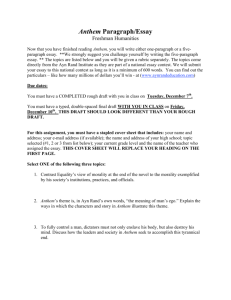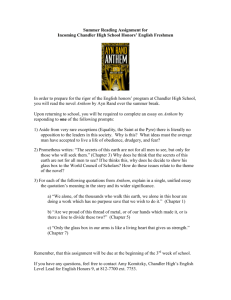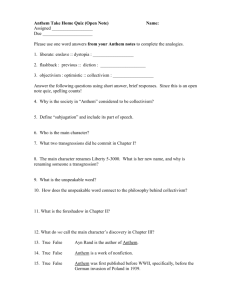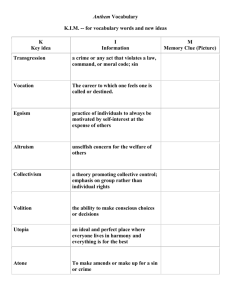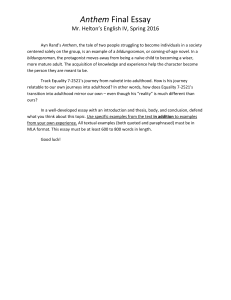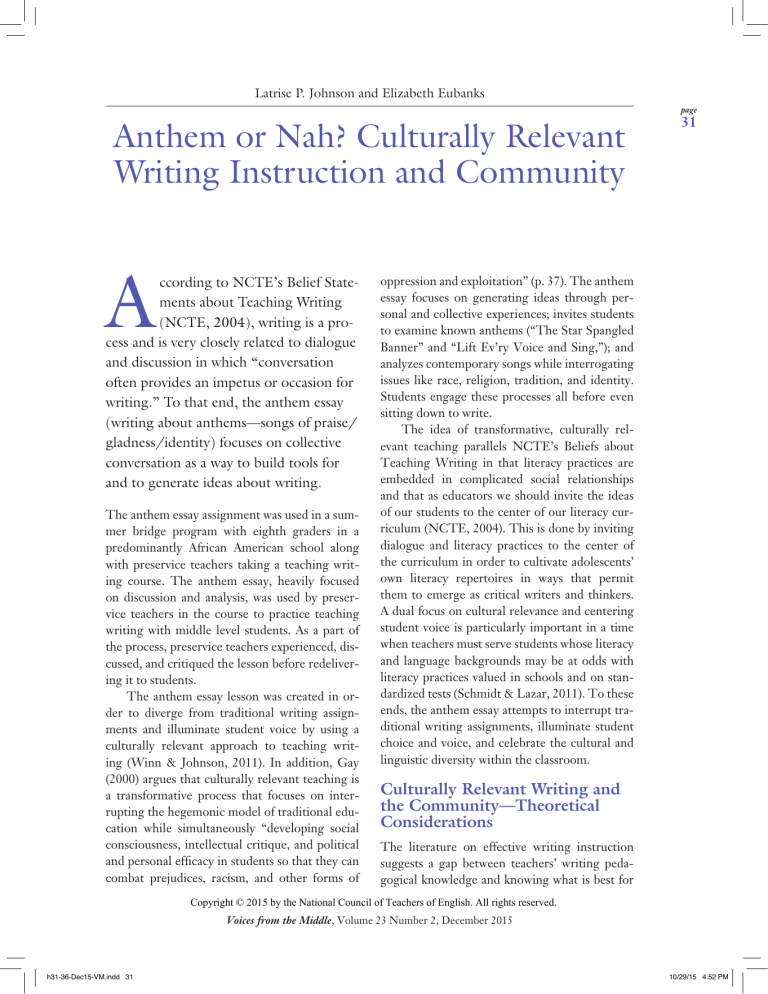
Latrise| P.Culturally Johnson and Elizabeth Eubanksand Community Johnson and Eubanks Relevant Writing Instruction page Anthem or Nah? Culturally Relevant Writing Instruction and Community A ccording to NCTE’s Belief Statements about Teaching Writing (NCTE, 2004), writing is a process and is very closely related to dialogue and discussion in which “conversation often provides an impetus or occasion for writing.” To that end, the anthem essay (writing about anthems—songs of praise/ gladness/identity) focuses on collective conversation as a way to build tools for and to generate ideas about writing. The anthem essay assignment was used in a summer bridge program with eighth graders in a predominantly African American school along with preservice teachers taking a teaching writing course. The anthem essay, heavily focused on discussion and analysis, was used by preservice teachers in the course to practice teaching writing with middle level students. As a part of the process, preservice teachers experienced, discussed, and critiqued the lesson before redelivering it to students. The anthem essay lesson was created in order to diverge from traditional writing assignments and illuminate student voice by using a culturally relevant approach to teaching writing (Winn & Johnson, 2011). In addition, Gay (2000) argues that culturally relevant teaching is a transformative process that focuses on interrupting the hegemonic model of traditional education while simultaneously “developing social consciousness, intellectual critique, and political and personal efficacy in students so that they can combat prejudices, racism, and other forms of 31 oppression and exploitation” (p. 37). The anthem essay focuses on generating ideas through personal and collective experiences; invites students to examine known anthems (“The Star Spangled Banner” and “Lift Ev’ry Voice and Sing,”); and analyzes contemporary songs while interrogating issues like race, religion, tradition, and identity. Students engage these processes all before even sitting down to write. The idea of transformative, culturally relevant teaching parallels NCTE’s Beliefs about Teaching Writing in that literacy practices are embedded in complicated social relationships and that as educators we should invite the ideas of our students to the center of our literacy curriculum (NCTE, 2004). This is done by inviting dialogue and literacy practices to the center of the curriculum in order to cultivate adolescents’ own literacy repertoires in ways that permit them to emerge as critical writers and thinkers. A dual focus on cultural relevance and centering student voice is particularly important in a time when teachers must serve students whose literacy and language backgrounds may be at odds with literacy practices valued in schools and on standardized tests (Schmidt & Lazar, 2011). To these ends, the anthem essay attempts to interrupt traditional writing assignments, illuminate student choice and voice, and celebrate the cultural and linguistic diversity within the classroom. Culturally Relevant Writing and the Community—Theoretical Considerations The literature on effective writing instruction suggests a gap between teachers’ writing pedagogical knowledge and knowing what is best for Copyright © 2015 by the National Council of Teachers of English. All rights reserved. Voices from the Middle, Volume 23 Number 2, December 2015 h31-36-Dec15-VM.indd 31 10/29/15 4:52 PM Johnson and Eubanks | Culturally Relevant Writing Instruction and Community page 32 students’ writing development (Read & LandonHays, 2013; Coker & Lewis, 2008). Many theories of writing instruction focus on the products of writing (FredrickOpportunities to write sen, Wilhelm, & Smith, 2012), while others focommunity may include cus on writing processes students thinking and (Smagorinsky, 2010). In classrooms that seek writing about their own to honor student voice experiences while expos- and engage students in critical literacy practice, ing how their membership teaching writing is usuto particular communities ally informed at least in part by several theories affect their construction of centering on processes knowledge, literacy partici- and products where the writing itself is relevant pation, and practice. (Ladson-Billings, 2014, Winn & Johnson, 2011), powerful (Ife, 2012), authentic (Kahn, 2009) and connected to the lives of students (Christensen, 2009; Kirkland, 2009). Winn and Johnson (2011) argue that culturally relevant writing pedagogy begins by helping students bridge gaps between their perspectives, ideas, and experiences while connecting these aspects of their identity to texts that examine social and political issues that may be at play in their lives. Such approaches focus on student voice and less on a narrow range of textual forms, conventions, or correctness. When students’ voices and lived experiences are at the center of writing instruction, students participate as knowing members of writing com- munities, and their ideas become an integral part of the learning in those spaces. Simply elevating products of writing (e.g., narrative, expository, persuasive) or focusing on fixed processes of writing are not enough to facilitate good writing. Good writing instruction, according to Winn and Johnson (2011), is focused on both process and product and provides “opportunities for students to collaborate, share, and exchange” (44). In other words, instruction that focuses merely on teaching the narrative or the five-paragraph essay, for example, does not invite students’ understanding of themselves, others, or the world. In order for students (and teachers) to understand community and eventually participate in writing to create a better world, we reimagine writing instruction as not only a vehicle for communication or language, but as a way of connecting one’s life to the world. This requires that learners are a part of a community of writers where their voices and ideas matter in the construction of knowledge through mutual engagement, they have complete access to the tools needed to engage in writing practice, and that they are accountable for their investment in learning. Culturally relevant writing requires that students question, reflect on, and interrogate issues and ideologies relevant to belonging to and/ or being excluded from broader communities. Embedded in the process of culturally relevant writing are practices inextricably linked to who/ how adolescents become in the world. Opportunities to write community may include students Connections from readwritethink In “I Hear My School Singing,” students use Walt Whitman’s list poem “I Hear America Singing” as the inspiration to critically reflect on key figures, memories, and events from their own educational community. They review their school Website and use a graphic organizer to analyze various aspects of their school environment. Using “I Hear America Singing” as a model, they then create list poems that reflect a representation of that community. Finally, they reflect upon those individuals or groups who might have been omitted from their poems. http://bit.ly/1KfD4pz Lisa Storm Fink www.ReadWriteThink.org Voices from the Middle, Volume 23 Number 2, December 2015 h31-36-Dec15-VM.indd 32 10/29/15 4:52 PM Johnson and Eubanks | Culturally Relevant Writing Instruction and Community page thinking and writing about their own experiences while exposing how their membership to particular communities affect their construction of knowledge, literacy participation, and practice. In order for teachers to create spaces where middle level students write community, writing instruction is reimagined and the narrative of each writer’s life is exposed, validated, and/or challenged through a constant interrogation of purpose and relevance. Notes on Methodology The researchers used case-study methodology in order to examine how one relevant and structured lesson can begin to prepare students to become more critical and competent writers. For this study, seven preservice teachers enrolled in a teaching writing course participated as writers in one relevant and structured lesson—the anthem essay—and redelivered the same lesson to 30 eighth graders at Eastern High School. Eastern is a neighborhood public school that serves a predominantly African American population (approximately 99%). The researchers took field notes, conducted classroom observations, and collected artifacts from the lesson, including handouts and student writing examples. This research examined how future teachers of writing used culturally relevant writing instruction to prepare middle level students to use dialogue, collaboration, shared knowledge, and collective experience in order to become critical and competent writers. meanings, and language. They were encouraged to think about their own personal connections to each anthem while thinking about their membership in different communities and how that membership informed their understanding of each anthem. During the discussion of the songs, issues of identity, race, and patriotism were present in students’ responses. For example, one student expressed the need for a Black national anthem. She explained, “Black people need another anthem that describes their experiences as Black people. The ‘Star-Spangled Banner’ was not really about us.” Here, this student explained her understanding of both anthems in order to interrogate her own cultural experiences within two similar texts. She challenged her existence in one anthem, confirmed it in the other, and added her individual voice to the collective construction of the definition of anthem. By reading and analyzing the songs as a community, the students were able to construct and refine the meaning of “anthem” while establishing characteristics of anthems. Students created a list of criteria (see Figure 1) that included: powerful music, story of struggle or facing adversity, victory, a collective group, uplifting lyrics or music, and personal meaning. These criteria were generated using individual and collective associations, dialogue, and discussion from the writing community. The lists were student generated, included their ideas, and were posted on the wall throughout the lesson since the criteria would 33 Constructing the Meaning of “Anthem” The first step of the anthem essay began with the completion of a word map for the word “anthem.” Students were encouraged to consider their individual histories with the word and construct a meaning that included these histories and associations created by a collective understanding. Then students were invited to analyze two anthems—“The Star Spangled Banner” and “Lift Ev’ry Voice and Sing.” Students read both and were asked questions about the songs’ histories, Figure 1. Examples of criteria generated by students Voices from the Middle, Volume 23 Number 2, December 2015 h31-36-Dec15-VM.indd 33 10/29/15 4:52 PM Johnson and Eubanks | Culturally Relevant Writing Instruction and Community page 34 provide the context for determining whether more contemporary songs could be considered anthems. Inviting students to construct meaning as a community generated ideas for their own writing. Making personal connections, collaboration, collective understanding—which were a result of dialogue and discussion—are vital to the ideas trait of good writing (Culham, 2003). Collaborative Learning and Preparing to Write Community We use the phrase write community in order to describe how adolescents use writing to connect their lived experiences in context of their belonging within larger communities. When students Figure 2. Anthem or Nah? group exercise write community, they collaborate, discuss, and come to shared understandings that require not only that they consider their own lived experiences, but understand others and the world around them. This is especially useful with emergent writers who may need to begin with their own narratives and existence. Writing community fosters new understandings of self and invites young adolescents to collaborate with others in order to think and write critically within and about communities. The next step of the anthem essay lesson required students to analyze more contemporary songs in order to determine whether they could be considered anthems. Each student group was given lyrics chosen by the writing teacher, including Modest Mouse’s “Float On,” Janelle Monae’s “Q.U.E.E.N,” and Beyonce’s “Run the World.” Each student group was asked a series of questions about their song using the criteria established in the previous step. Student groups completed the “Anthem or Nah?” handout (see Figure 2) and used collaboration and analysis of each song to determine whether or not the given song was an anthem. Using the criteria as tools for their ideas and by citing evidence from the text, students shared whether their song could be considered an anthem. During the class discussion, students debated and discussed how their personal experiences, when considered in broader contexts of community, provided them with useful and critical ideas to write about. During the third step of the process, students were then asked to choose their own personal anthem. Students identified the criteria that qualified their song as an anthem and highlighted supporting evidence from the song’s lyrics and music, again providing a foundation of main ideas with concrete evidence to use later during their writing. The final step of the process involved inviting students to compose their anthem essays, for which they wrote about personal and collective ideas. This step of the process illuminates that students do not have to write alone—that they can use collaboration and dialogue with their Voices from the Middle, Volume 23 Number 2, December 2015 h31-36-Dec15-VM.indd 34 10/29/15 4:52 PM Johnson and Eubanks | Culturally Relevant Writing Instruction and Community page peers in order to generate meaningful ideas that are individual and communal. Composing the anthem essay required that students work individually; however, it encouraged them to consider the ideas of others in the community—which forced them to think about how their ideas fit into larger contexts. Because the process invited students to construct meaning together, they were equipped with the ideas and knowledge of the community. The process prepared students to write not only for themselves, but to connect their own ideas and experiences to those beyond them. Centering Student Voice and Considering Community By illuminating student voice and choice, the anthem essay lesson allows for collaboration and dialogue about issues of identity, race, tradition, gender, and other social issues that impact students’ lives. Together and individually, students interrogate issues that they encounter. For example, one student in this group questioned the social construction of what it means to be a young female in the world through her ideas related to Bruno Mars’s song “Just the Way You Are.” She wrote: which is largely focused on how the students see themselves in relation to each other, the world, and to different types of texts. 35 Conclusion The process used to teach the anthem essay (see Figure 3) interrupts the idea that writing is merely about composing by including opportunities for talk. Long before middle level students sat down to compose their essays, they interrogated their own ideas, ideas from the community, and analyzed several texts. Such opportunities provided students with the tools needed in order to construct relevant ideas for their own writing. As writers and teachers of writing, we are met with the challenge to locate experiences within [This song] makes me feel confident about who I am and brave to be who I want to be. The challenge in this song is to change how you feel about yourself so that you love yourself. She notes her dissociation with the social expectation of young girls and how she thinks this song has an empowering message for women. The anthem essay centers student voice while acknowledging students’ membership in broader communities—including the writing community. Young adolescents learn that ideas are generated through considering their personal experiences while considering their membership in other communities beyond the classroom. Through collaboration and dialogue, students are involved in formulating ideas and building a foundation for writing long before sitting down to write. While the anthem essay invites students to write an expository essay, it also requires that students carefully consider a process of writing, Figure 3. The anthem essay step-by-step guide Voices from the Middle, Volume 23 Number 2, December 2015 h31-36-Dec15-VM.indd 35 10/29/15 4:52 PM Johnson and Eubanks | Culturally Relevant Writing Instruction and Community page 36 our writing instruction that compel our students to make meaning of their worlds. Through the processes included in the anthem essay, young writers defined individual and communal concerns, critiqued the status quo, and imagined a more just and equitable future. Providing writing instruction that will lead to creating critical and competent writers requires that educators reimagine writing and As writers and teachers of writing instruction, foswriting, we are met with ter a writing community within and outside the challenge to locate expe- classrooms, and enact riences within our writing culturally relevant pedagogies—practices that instruction that compel our prepare students to betstudents to make meaning ter understand themselves, others, and the of their worlds. world. References Christensen, L. (2009). Teaching for joy and justice: Re-imagining the language arts classroom. United States of America: Rethinking School. Coker, D., & Lewis, W. E. (2008). Beyond writing next: A discussion of writing research and instructional uncertainty. Harvard Educational Review, 78(1), 231–251. Culham, R. (2003). 6 + 1 traits of writing. New York, NY: Scholastic Professional Books. Fredricksen, J. E., Wilhelm, J. D., & Smith, M. W. (2012). So, what’s the story?: Teaching narrative to understand ourselves, others, and the world. Portsmouth, NH: Heinemann. Gay, G. (2000). Culturally responsive teaching. New York, NY: Teachers College Press. Ife, F. (2012). Powerful writing: Promoting a political writing community of students. English Journal, 101(4), 64–69. Kahn, E. (2009). Making writing instruction authentic. English Journal, 98(5), 15–17. Kirkland, D. E. (2009). The skin we ink: Tattoos, literacy, and a new English education. English Education, (4), 375. Ladson-Billings, G. (2014). Culturally relevant pedagogy 2.0: aka the remix. Harvard Educational Review, 84(1), 74–84. National Council of Teachers of English (NCTE) Writing Study Group of the NCTE Executive Committee. (2004). NCTE beliefs about the teaching of writing. Retrieved from http://www .ncte.org/positions/statements/writingbeliefs. Read, S., & Landon-Hays, M. M. (2013). The knowing/doing gap: Challenges of effective writing instruction in high school. Teaching/Writing: The Journal of Writing Teacher Education, 2(2), Article 3. Schmidt, P. R., & Lazar, A. M. (2011). Practicing what we teach: How culturally responsive classrooms make a difference. New York, NY: Teachers College Press. Smagorinsky, P. (2010). The dynamics of writing instruction. Portsmouth, NH: Heinemann. Winn, M. T., & Johnson, L. P. (2011). Writing instruction in the culturally relevant classroom. Urbana, IL: National Council of Teachers of English. Latrise P. Johnson, NCTE member since 2007, is an assistant professor of Secondary English Language Arts and Literacy at University of Alabama. Elizabeth Eubanks is a graduate student pursuing a MA in Secondary English Language Arts Education. Voices from the Middle, Volume 23 Number 2, December 2015 h31-36-Dec15-VM.indd 36 10/29/15 4:52 PM
